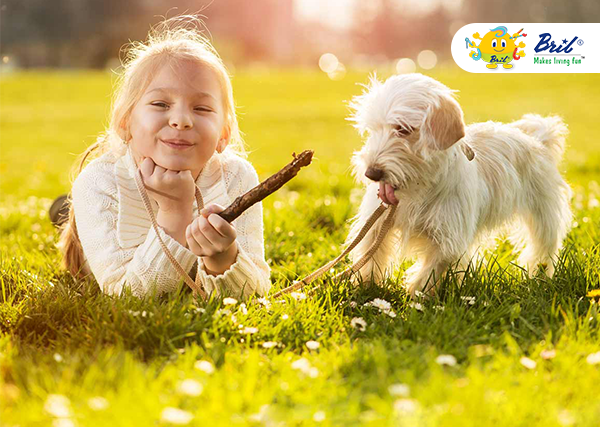
Children and pets (mostly dogs & cats) generally have a friendly and loving relationship. Social media is bursting with adorable videos and images which are testimonial to this very special bond. Cuddling, playing, eating, sleeping, and bathing; almost every daily activity is done together and they are inevitably inseparable. But this bond comes with some responsibility after all a pet is an animal and animal instincts are strong and at times unpredictable. Parents must ensure that this relationship grows in a safe & secure environment and both the pet & child cherish these moments for a long time to come.
Train Your Pets: Dogs are naturally very protective of children and one doesn’t really need to worry much; dogs and babies very organically develop a strong attraction for each other. But even so, train your pets especially dogs, to control their body movements & gestures when near the child. For e.g. in case of big dogs, which are strong, one wrong or swift movement could harm your child. Make sure you introduce them to your child by sitting next to them, petting them continuously and keeping treats ready too.
Train Your Child: It is equally important for children to respect and understand the pet’s emotions and bodies. Teach your child how to be gentle with them, to pet& gently scruff a cat or dog, to not pull their tails or ears which could get the pet to react aggressively or even to honour their space and time by not continuously petting or touching them and only engaging in the same when the pet comes to them for affection.
To Be Mindful of the Pet’s Body Language: Children have tendencies to make fun or play along which might not blend with the dog’s mood; ensure that your children are aware of certain behaviour which they need to adhere to with pets. Children if taught to understand the dog’s body language, like whether the dog has had enough interaction or doesn’t like something, they will be in a better position to understand & bond with the dog or cat for that matter.
Teach To Treat: Your children should learn certain ways to feed or treat the pet, especially a dog which could a get bit aggressive and nip at them for treats. Maybe they could practice certain treating techniques with a stuffed dog and then try them on a real dog. Techniques like tossing, dropping on the ground, or feeding with an open hand are generally the most common ways of treating a dog. Also telling the dog to ‘sit’, or ‘give a shake-hand or shake-paw’ will get the dog to behave well for his treat. They associate good behaviour with treats and this association will avoid any nipping or biting.
Walking Along With The Dog: Many times the dog is dragging the owner along or vice-versa, both are not advisable in the long run. Walk along with your dog. Stop at places the dog wants to; your child needs to understand this time is for the dog, it has the right to stop, smell, urinate and embrace any other natural instincts. Once the dog realises you honour its stance, it avoids pulling or tugging at the leash. Of course it hugely depends on the dog’s temperament; some are extremely hyperactive and will tug at the leash to some extent but even so, this understanding created during the walk will be of great help.
Growing up with pets will help build your child’s character. They become kind, loving and patient beings.They become more sensitive towards animals and the environment and develop a calm and peaceful nature. Pets, dogs more often, are loyal and have a keen insight of human beings’ emotions, and prove to be great companions. Positive reinforcement, fun tools, which keep them occupied and make them independent, and exposure to outside environment like parks keep them healthy and happy. You will never get enough of this pet-child relationship and your home will always be seething with positive vibes & energy.